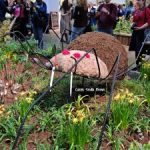A few days ago, not long after Christmas, I was standing in my upstairs bedroom, newly showered, digging through my underwear drawer. It had snowed heavily the day before–a rarity down here in North Carolina–and the whole world was glittering white snow and black trunks. I was staring vaguely out the window while doing that complicated motion where you try to dig something from the back of the drawer without removing the contents in front, and then I saw…them.
I didn’t dither over identification. There’s nothing else in North America that looks like that.
“OH MY GOD!” I screamed. “WILD TURKEYS!”
Probably other birders have spotted great birds while trying to locate clean underwear, but you don’t hear about it often. I abandoned the quest for underwear and began a more pressing quest for binoculars. (Hey, the drawer wasn’t going anywhere. The turkeys were on the move.)
The flock had over a dozen individuals, which pleased my boyfriend enormously, since the last time he saw them—a full decade ago—there were seven. They were strolling sedately through the woods behind the house, stopping occasionally to flap their wings and root around in the snow. I think it’s likely that they’ve been there this entire time, but without the deep snow, I can’t imagine how anyone could spot them—dark mottled shapes on dark mottled leaf litter a long way off. You’d have to look in exactly the right place at the right time, or they’d have to come much closer to the house.
I was delighted to see them, and all the more so because I hadn’t done anything to deserve them.
Much of wildlife gardening consists of trying to attract wildlife, often from the ground up with native plants. It is a story of little successes. You plant a half dozen milkweed and a bunch of asters, and when the monarchs arrive, there’s a moment of triumph. You put in the frog pond and one day there are plop! noises as you walk by, and you know the frogs have come. (It’s a story of little failures, too, of course—I have nailed up bluebird houses every year and they’ve never shown up, and I know people whose porches groan under the weight of unvisited hummingbird feeders.) But generally you do the right things—you don’t use the pesticides and you plant the natives and you put out the birdseed and the water and you leave the brushpile or the standing dead tree—and good stuff happens.
The turkeys, though, had nothing to do with me. They were there before I showed up, they’ll likely be there after I leave. They are uninterested in my garden. I have done nothing to attract them, as dumping out corn in winter would probably get me a great many hungry deer, and there are enough of those already. (There are apparently other things you can do for wild turkeys—many of them seem to begin with “Own a hundred acres of mature hardwoods” so I haven’t ever pursued it at any length, but now that I know they’re out there, I may have to look into it.)
So seeing these absurd, ungainly, magnificent birds was a gift, pure and simple—unearned, but very much appreciated.
More From Ecosystem Gardening:
Submit your review | |








